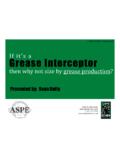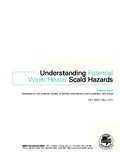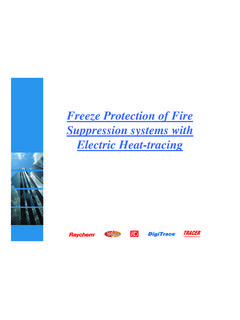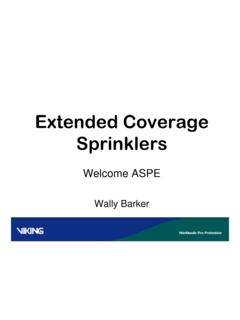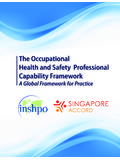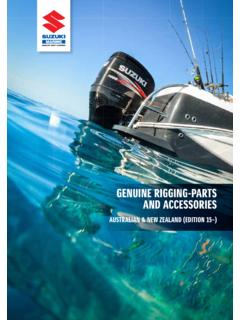Transcription of ASSE 1055 Chemical Dispensers - ASSE International
1 asse 1055 Chemical Dispensers Use, Installation, and Design July 2, 2015 2nd Edition asse International 2015 Executive Summary asse 1055 devices are as effective as asse 1001 devices for protecting against high hazard substances entering the potable water system. Most devices consist of an elastomeric gap ( e gap, flex gap, etc.) acting as a check valve that vents to atmosphere when the device is not under pressure. They protect against backsiphonage and low levels of backpressure up to a head height equal to the length of hose supplied. When attached to a faucet that contains an internal asse 1001 or asse 1011 device, the asse 1055 device must have a pressure bleed device as a part of that connection, and the faucet be shut off when not in use. Otherwise the asse 1001 or 1011 device would be under continuous pressure and that is not the intent of those device designs. It is critical that local jurisdictions mandate and enforce this as this is an installation requirement and not a performance requirement within asse 1055.
2 What is an asse 1055 device? An asse 1055 device is a Chemical dispenser. Its goal is to dilute a concentrated solution inline such that the ready to use, mixed solution can be dispensed with minimal waste and footprint. Chemical Dispensers are comprised of (2) main components in order from the inlet: a backflow prevention device, and a mixing chamber. This basic design can manifest itself in a variety of products whether it be a bottle filling device in a janitorial closet for cleaning solutions, a soap mixer at a commercial car wash station, laundry systems, or dishwashers. Note that the types of substances used in the applications are not desired in the potable water supply. asse International , as a leading voice of backflow protection, and its partners wrote the asse 1055 standard in order to address concerns about the backflow protection of high hazard materials. Protection methods against high hazard contaminants1 and low hazard pollutants2 are well known.
3 Table 1 gives a list of the different variety of devices that can be used to protect against high hazard substances under a backsiphonage condition, and which can be used within 1055 devices. Standard Description Used within 1055? asse 1001 Atmospheric type vacuum breakers Yes asse 1002 Anti siphon fill valves for water closet tanks asse 1011 Hose connection vacuum breaker asse 1013 Reduced pressure principle backflow protector Yes asse 1019 Wall hydrant with backflow protection and freeze resistance asse 1020 Pressure vacuum breaker assembly Yes asse 1047 Reduced pressure detector assembly asse 1052 Hose connection backflow preventer asse 1053 Dual check backflow preventer wall hydrants freeze resistant type asse 1056 Spill resistant vacuum breaker Yes ASME Air gaps in plumbing systems (for plumbing fixtures and water connected receptors) Yes Table 1 A backflow protection device must comply with at least one of these standards in order to offer high hazard protection.
4 1 Contaminants cause harm to human health, per the asse Plumbing Dictionary, 6th Ed. 2 Pollutants cause foul odor, taste, or change in visual appearance but are safe to ingest, per the asse Plumbing Dictionary, 6th Ed. asse International 2015 The particular substances that are considered high hazard or low hazard are left up to the local authorities having jurisdiction (AHJ). At the same time, a list of generally accepted facilities utilizing high hazard solutions in their processes that could contaminate the water supply are given in Appendix A. It is important to reinforce the fact that asse 1055 devices give high hazard backflow protection. For example an RPZ installed upstream will give no significant additional backflow protection. What is not an asse 1055 device? An asse 1055 device is not required if any of these (3) criteria are met: 1.
5 Backflow protection is located further upstream; 2. There is no mixing of water and Chemical concentrate; 3. There are no means for a connection to potable water. This means that faucet mounted proportioning valves, drum mounted proportioning valves & hand pumps, peristaltic pumps, bottle Dispensers , and foamers are all examples of non 1055 system types. Example images of these can be found in Appendix B. As with any other fixture or fitting, asse 1055 devices must be installed as per the local AHJ. Elastomeric Gaps There is a class of devices known as elastomeric gaps (also known as e gaps, flex gaps, and action gaps) that comprise the majority of asse 1055 devices. Operation of these devices are similar to atmospheric vacuum breakers ( asse 1001) applied downstream of flushometers, where water flows past a single check, and where its air vents are closed when under pressure, and open when not under pressure.
6 Figure 1 Cross sections of example elastomeric gap devices and their features. asse International 2015 asse 1055 asse 1001 Hydrostatic test of assembly 188psi or mfg rating 250psi or 2x mfg rating Performance under manufacturer's temperature & pressure Maximum, simultaneous temperature & pressure 110 F or 180 F, then 250psi or 2x mfg Pressure loss / flow capacity 10psi at rated flow Air inlet shield Dimensional check Air flow test Yes Backsiphonage test Hold check open Fouled check Female connections No interference Tipping 10deg Backpressure Table 2 Comparison of all performance requirements between the asse 1055 and asse 1001 standards. Per Table 2, there are some differences between the two standards. The hydrostatic test is performed above the manufacturer s rating; Its performance is tested at the simultaneously applied manufacturer s rated temperature and pressure; asse 1055 does test for flow performance; The backsiphonage test achieves the same goals; The requirement of female connections has to do with testing for reduced flow capacity; Tipping is not germane to the backflow discussion; asse 1055 requires a device to withstand 10ft of head pressure with a raised hose unlike asse 1001 which requires the device not be subjected to any backpressure.
7 With respect to the air inlet, elastomer gaps are normally within the main assembly of the 1055 device, which can include a shroud or outside cover. The goal of the air flow test in the asse 1001 standard is to verify that the air flow capacity past the check meets or exceeds the air flow capacity past the vents. The restriction in flow must be at the check, not the air vents, in case of backsiphonage. However, because an asse 1055 device must be able to withstand a small amount of backpressure ( or 6in of water) for 5 minutes, this means that the check is normally closed and requires a cracking pressure >0psi. Any backsiphonage will act against that check and will not allow air to flow past. Therefore, an air inlet test is not appropriate for an asse 1055 device. Elastomer Gaps are not Air Gaps While an asse 1055 device may include an air gap, it needs to be stated that elastomer gaps themselves should not be regarded as air gaps as per ASME 2012.
8 The reason is because a seal needs to be created by the elastomer when water is flowing to create the venturi effect in order to draw in the Chemical concentrate. The venturi effect is caused by the flow past a bottleneck combined with an inlet port at the middle of the bottleneck. That flow cannot happen without the assistance of line pressure and the seal given the typical geometry of these devices. Connections to Potable Water Most 1055 devices are installed after the building and health inspections have been completed. The most common connection made is to a faucet with a hose connection, either on a service sink in a asse International 2015 janitorial room or on a 3 station sink in a commercial kitchen. Less common are connections made to a dedicated water line. Faucet Connections Many newer faucets in the field have integrated asse 1001 or 1011 devices in their assemblies combined with a hose connection at the outlet.
9 These devices are downstream of the hot and cold shut off valves so that they are not under continuous pressure. This design is so temporary connections (less than 12 hours) can be made via hose to fill a bucket or to connect to a Chemical dispenser. The problem is that temporary connections can become permanent. When a hose connection is permanent and there is an asse 1001 or 1011 upstream of it, there must be a pressure bleed device (PBD) installed. Water will flow out of the PBD as long as the faucet is turned on. Having the water on for more than 12 hours is still considered a permanent connection, so when the device is not in use, the faucet needs to be turned off. A visual indicator of running water should be enough to prompt a user to turn it off. Figure 2 Example pressure bleed device. If a faucet does not contain an integrated asse 1001 or 1011 device, there is no issue as the 1055 device can have a shutoff upstream of the backflow device.
10 If there is no shut off, there will be a flow from the outlet of the Chemical dispenser. This is only permissible for over 12 hours if within the 1055 device is a 1013, 1020, or 1056 backflow preventer device. Connections to a Dedicated Line When an asse 1055 device is connected to a separate, dedicated source of water independent from a faucet, the device either needs to employ a shut off at its inlet, or integrate a backflow prevention device capable of being under continuous pressure: specifically an asse 1013, 1020, or 1056 device. Conclusion asse 1055 devices provide the desired high hazard backflow protection when installed correctly. Appendix A From the asse Guide to Cross Connection Protection Devices and Assemblies Application & Selection, 2nd Ed.: The following list includes, but is not limited to, typical examples of buildings considered to be a high hazard facility should a backflow condition occur: Animal care facility Beauty salon Car wash Chemical research plant Dental office Dry cleaning facility Fire station Funeral home Garden center / nursery Hospital Industrial building Manufacturing facility Marina, including docks & piers Medical facility Morgue High school & middle school Sewage treatment plant Sports complex Strip mall stores off of a single water meter Also, when there is limited or restricted access to a building, it is necessary to classify the building itself as high hazard.
